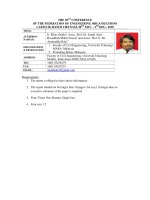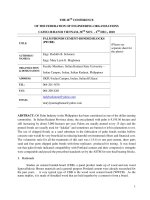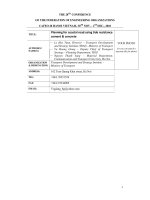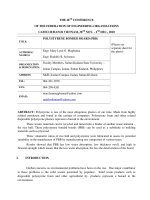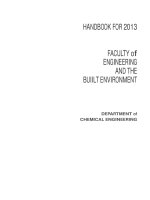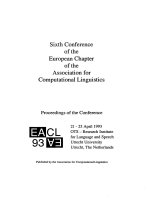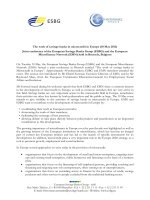THE 28TH CONFERENCE OF THE FEDERATION OF ENGINEERING ORGANIZATIONS
Bạn đang xem bản rút gọn của tài liệu. Xem và tải ngay bản đầy đủ của tài liệu tại đây (148.67 KB, 11 trang )
1
THE 28
TH
CONFERENCE
OF THE FEDERATION OF ENGINEERING ORGANIZATIONS
CAFEO 28 HANOI VIETNAM, 30
TH
NOV. - 2
ND
DEC., 2010
TITLE:
PALM FRONDS CEMENT-BONDED BLOCKS
(PFCBB)
(Please see
separate sheet for
the photo)
AUTHOR(S)’
NAME(S):
Engr. Rodolfo B. Solomon
Engr. Mary Lynn G. Magbanua
ORGANIZATION
& DESIGNATION:
Faculty Members, Sultan Kudarat State University –
Isulan Campus, Isulan, Sultan Kudarat, Philippines
ADDRESS:
SKSU-Isulan Campus, Isulan, Sultan KUdarat
TEL:
064-201-3878
FAX:
064-200-4261
EMAIL:
ABSTRACT: Oil Palm Industry in the Philippines has been considered as one of the dollar earning
commodity. In Sultan Kudarat Province alone, the area planted with palm is 9,195.56 hectare and
still increasing by about 3,000 hectares per year. Palms are usually pruned every 15 days and the
pruned fronds are usually used for “kalakat” and sometimes are burned or left in plantations to rot.
The use of chipped fronds as a sand substitute in the fabrication of palm fronds residue hollow
concrete unit would be very beneficial in reducing harmful environmental effects and financial cost.
The volumetric ratio for all the treatments of this unit was (1:3:4) or one part cement, three parts
sand and four parts chipped palm fronds with three replicates produced for testing. It was found
out that palm fronds indicated compatibility with Portland cement and their compressive strengths
were comparable and passed the prescribed standards set by the ASTM for non-load bearing blocks.
I. Rationale
Studies on cement bonded-board (CBB), a panel product made up of wood and non wood
lignocellulosic fibrous materials and a general purpose Portland cement were already researched for
the past years. . A very typical type of CBB is the wood wool cement board (WWCB). As the
name implies, it is made of shredded wood that are held together by a cement to form a board.
2
A number of wood species that were found to be suitable for WWCB manufacture are
kaatoan bangkal (Anthocephalus chinensis), antipolo (Artocarpus communis), yemane (Gmelina
arborea), giant ipl-ipil (Leucaena leucocephala), binuang (Octomeles Sumatra) and many more
6)
.
The suitability of some Philippine grown Australian introduced species like acacias and eucalyptus
for WWCB have been reported and contributed significantly in determining their technically viable
for board manufacture
1-4)
.
Expansion of raw material base is a continuing process in the development of composite
panels. Available lignocellulosic fibrous materials that have the potential of being a component for
WWCB have to be considered. In WWCB technology however, board properties vary depending
on the wood species used and its subsequent effects on wood to cement ratio, amount of water,
board density, cement setting accelerator, etc.
The worldwide acceptance of Wood Wool Cement Board proves its versatility and, not least
important, its durability in any climatic condition
7)
.
Conventional hollow concrete masonry unit (HCMU) consists of sand as its aggregate and
cement as its binder. However, there is a growing interest in substituting alternative aggregates
materials, largely as a potential use for recycled materials. There is significant research on many
different materials for aggregate substitutes such as granulated coal ash, blast furnace slag or
various solid waste including fiber glass or various solid waste including fiberglass waste materials,
granulated plastics, paper, wood product and others
8)
.
Oil palm, which is considered to be abundant in the Philippines, needs to be studied for
cement board production. The oil palm industry in Sultan Kudarat started in 1966 with 4,500
hectares nucleus farm and out growers’ scheme. In 2008 report, it has reached 9,195.56 hectares
distributed in the different municipalities as follows: Bagumbayan 649.15, Columbio 943.15,
Esperanza 308.09, Isulan 2,660.77, Lambayong 506.64, Lutayan 82.06, President Quirino 1,025.65,
Sen. Ninoy Aquino 170.57 and Tacurong City 2,849.48. In 2000, there was a significant increase
in the number of hectarage planted to palm trees. According to Calong (2010) of Kenram Industrial
Development Inc. (KIDI), there was an increase of 1,000 hectares per year since 2000 and
AGUMIL with 3,000 hectares per year and still increasing up to this time.
In some parts of Sultan Kudarat, palm fronds weaving provide a source of living to some of
its citizen. Palm fronds are hard, fibrous, flexible materials used for “ kalakat ” making. The fronds
extracted from palm fronds produces a soft residue which contains fibers and estimated amounts of
this residue is about 1.3million tones per annum. Large quantities of this waste are unused.
This paper explores the possibility of utilizing these residue as an alternative aggregates in
hollow CMU and specifically aimed to lessen the amount of natural aggregates and replace it by
palm fronds residue to minimize the natural aggregates needed.
3
II. Objectives
The main objective of this research is to make building blocks out of palm fronds waste and
compare it with the conventional HCMU. Specifically, it determined:
1. The compressive strength of cured and uncured PFCBB in 7, 14 and 28 days.
2. The compressive strength of cured and uncured HCMU in 7, 14 and 28 days.
3. The significant difference between the compressive strength of cured and uncured
PFCBB.
4. The significant difference between the compressive strength of cured PFCBB and the
cured commercial blocks.
III. Methodology
Research design
The variables involved are chipped palm fronds, cement, sand and water. The unit was put
through a compression test using the Universal Testing Machine (UTM). The boards were tested
after 7, 14 and 28 days with curing and without curing. The volumetric ratio used was (1:3:4) or
one part cement, 3 parts sand and four parts chipped palm fronds with three replicates was produced
for testing.
Manufacturing Procedure
In order to meet the requirements needed in this study material gathering and good
manufacturing procedures were followed.
Materials
The inner portion of the oil palm fronds were used as raw material and general-purpose
Portland cement was used as binder.
Methods
1. Collection:
Palm fronds were taken from the farm and from the kalakat weavers of Sultan Kudarat.
2. Shredding
Oil palm fronds were processed through a shredding machine to produce wood wool or
wood strands with approximately 0.40 mm thick and 4-5 mm wide.
3. Pretreatment
4
Shredded materials were soaked in water for 24 hours to leach out water soluble
extractives that are inhibitory to cement setting. This will be followed by air drying to
attain a moisture content of 20-25%.
4. Measuring and mixing
Predetermined amount of shredded material, cement and water were measured as per
experimental design. Manual mixing of predetermined amount of air dry excelsior,
cement and water were done on a plastic basin.
5. Forming and pressing
The mixture were evenly distributed into a mold to form a concrete masonry unit with a
thickness of 100 mm by 200 mm x 400 mm for 24 hrs. This will be followed by 28
day conditioning.
Experimental Design
Constant Factors:
CMU size : 100mm x 200mm x 400mm
Water : 80% based on cement weight
Calcium chloride : 3% based on cement weight
Soaking time : 24 hours
Curing Condition : Ambient room temperature/water spraying for cured
samples
Variable factors : Volumetric Ratio
Cement : Sand : fronds = 1 : 3 : 4
Compressive strength testing
The compressive strength of the samples was tested using Universal Testing Machine.
5
IV. Results and Discussion:
Table 1. Compressive strength of uncured and cured PFCBB and commercial HCMU
D
D
U
U
R
R
A
A
T
T
I
I
O
O
N
N
(
(
d
d
a
a
y
y
s
s
)
)
P
P
F
F
C
C
B
B
B
B
C
C
O
O
M
M
M
M
E
E
R
R
C
C
I
I
A
A
L
L
H
H
C
C
M
M
U
U
U
U
n
n
c
c
u
u
r
r
e
e
d
d
(
(
M
M
P
P
a
a
)
)
C
C
u
u
r
r
e
e
d
d
(
(
M
M
P
P
a
a
)
)
U
U
n
n
c
c
u
u
r
r
e
e
d
d
(
(
M
M
P
P
a
a
)
)
C
C
u
u
r
r
e
e
d
d
(
(
M
M
P
P
a
a
)
)
7
7
0
0
.
.
0
0
0
0
9
9
0
0
5
5
0
0
.
.
0
0
1
1
2
2
9
9
1
1
2
2
.
.
0
0
2
2
2
2
.
.
6
6
1
1
1
1
4
4
0
0
.
.
0
0
2
2
2
2
6
6
0
0
0
0
.
.
0
0
8
8
9
9
2
2
4
4
4
4
.
.
1
1
1
1
4
4
.
.
8
8
7
7
2
2
8
8
0
0
.
.
0
0
5
5
4
4
4
4
8
8
0
0
.
.
6
6
1
1
6
6
7
7
0
0
8
8
.
.
2
2
1
1
1
1
0
0
.
.
2
2
0
0
The greatest compressive strength of the uncured and cured PFCBB was achieved in 28
days and the least was in 7 days.
Similarly, the greatest compressive strength of the uncured and cured commercial HCMU
was recorded in 28 days and the least was in 7 days.
